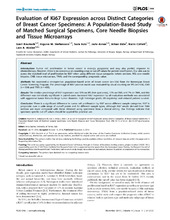| dc.contributor.author | Knutsvik, Gøril | en_US |
| dc.contributor.author | Stefansson, Ingunn | en_US |
| dc.contributor.author | Aziz, Sura Mohammed | en_US |
| dc.contributor.author | Arnes, Jarle | en_US |
| dc.contributor.author | Eide, Johan | en_US |
| dc.contributor.author | Collett, Karin | en_US |
| dc.contributor.author | Akslen, Lars A. | en_US |
| dc.date.accessioned | 2015-03-24T13:11:11Z | |
| dc.date.available | 2015-03-24T13:11:11Z | |
| dc.date.issued | 2014-11-06 | eng |
| dc.identifier.issn | 1932-6203 | |
| dc.identifier.uri | https://hdl.handle.net/1956/9627 | |
| dc.description.abstract | Introduction: Tumor cell proliferation in breast cancer is strongly prognostic and may also predict response to chemotherapy. However, there is no consensus on counting areas or cut-off values for patient stratification. Our aim was to assess the matched level of proliferation by Ki67 when using different tissue categories (whole sections, WS; core needle biopsies, CNB; tissue microarrays, TMA), and the corresponding prognostic value. Methods: We examined a retrospective, population-based series of breast cancer (n = 534) from the Norwegian Breast Cancer Screening Program. The percentage of Ki67 positive nuclei was evaluated by visual counting on WS (n = 534), CNB (n = 154) and TMA (n = 459). Results: The median percentage of Ki67 expression was 18% on WS (hot-spot areas), 13% on CNB, and 7% on TMA, and this difference was statistically significant in paired cases. Increased Ki67 expression by all evaluation methods was associated with aggressive tumor features (large tumor diameter, high histologic grade, ER negativity) and reduced patient survival. Conclusion: There is a significant difference in tumor cell proliferation by Ki67 across different sample categories. Ki67 is prognostic over a wide range of cut-off points and for different sample types, although Ki67 results derived from TMA sections are lower compared with those obtained using specimens from a clinical setting. Our findings indicate that specimen specific cut-off values should be applied for practical use. | en_US |
| dc.language.iso | eng | eng |
| dc.publisher | PLoS | eng |
| dc.relation.ispartof | <a href="http://hdl.handle.net/1956/15344" target="blank">Biomarkers in breast cancer, with special focus on tumor cell proliferation</a> | |
| dc.rights | Attribution CC BY | eng |
| dc.rights.uri | http://creativecommons.org/licenses/by/4.0/ | eng |
| dc.title | Evaluation of Ki67 expression across distinct categories of breast cancer specimens: A Population-based study of matched surgical specimens, core needle biopsies and tissue microarrays | en_US |
| dc.type | Peer reviewed | |
| dc.type | Journal article | |
| dc.date.updated | 2015-03-03T15:00:38Z | en_US |
| dc.description.version | publishedVersion | en_US |
| dc.rights.holder | Copyright 2014 Knutsvik et al. | |
| dc.source.articlenumber | e112121 | |
| dc.identifier.doi | https://doi.org/10.1371/journal.pone.0112121 | |
| dc.identifier.cristin | 1213197 | |
| dc.source.journal | PLoS ONE | |
| dc.source.40 | 9 | |
| dc.source.14 | 11 | |
| dc.relation.project | Norges forskningsråd: 223250 | |
| dc.relation.project | Norges forskningsråd: 191778 | |
| dc.subject.nsi | VDP::Medical sciences: 700::Health sciences: 800::Epidemiology, medical and dental statistics: 803 | eng |
| dc.subject.nsi | VDP::Medisinske fag: 700::Helsefag: 800::Epidemiologi medisinsk og odontologisk statistikk: 803 | nob |

